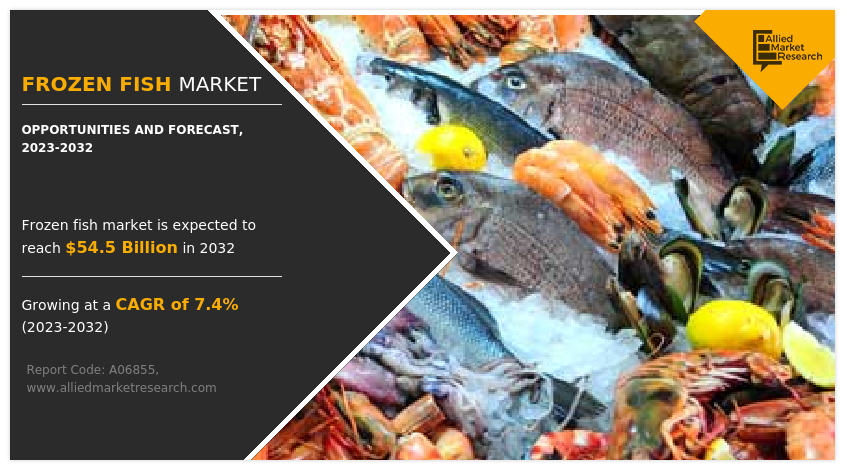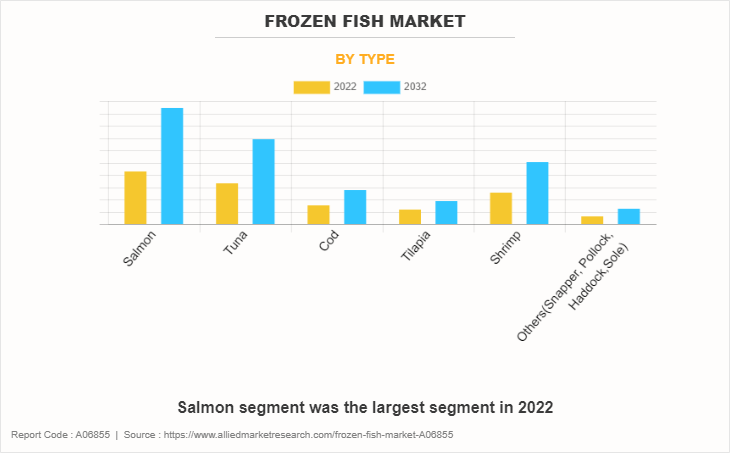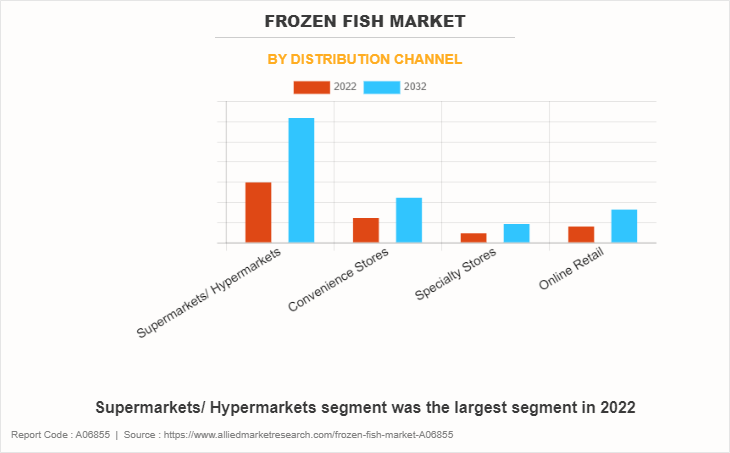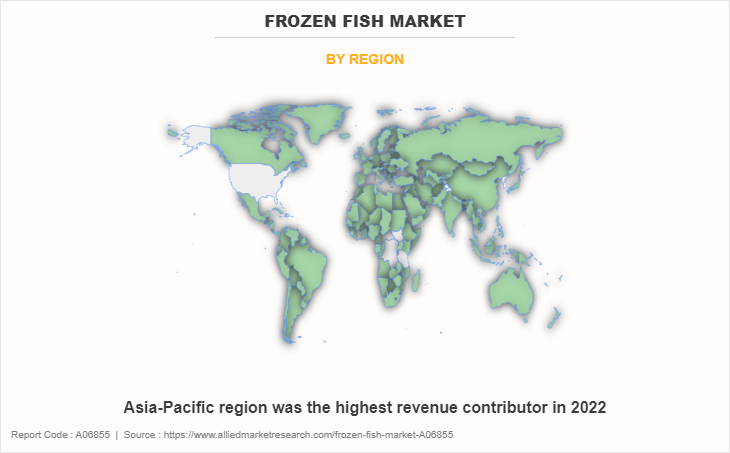Frozen Fish Market Research, 2032
The global frozen fish market size was valued at $26.9 billion in 2022, and is projected to reach $54.5 billion by 2032, growing at a CAGR of 7.4% from 2023 to 2032.
Frozen fish refers to seafood that has been preserved by freezing it to extremely low temperatures and typically below 0 degrees Fahrenheit (-18 degrees Celsius) or even lower. This process is used to maintain the freshness and quality of the fish for an extended period by slowing down the growth of microorganisms, enzymes, and chemical reactions that can lead to spoilage.
Frozen fish can include a wide variety of species, such as salmon, cod, shrimp, tilapia, and others. The freezing process involves quickly lowering the temperature of the fish to freeze the water content within the fish's flesh. This prevents the formation of large ice crystals that can damage the cell structure and texture of the fish. Properly frozen fish can retain its nutritional value, flavor, and texture, making it a convenient and long-lasting option for consumers. It is mostly available in supermarkets and seafood markets and is a popular choice for both home cooking and in the food industry for various dishes and seafood products.

Market Dynamics
Consumer preferences for convenient, longer-lasting food options have driven the demand for frozen fish products. Frozen fish offers a convenient way to access seafood and especially in areas where fresh seafood is not easily available. Frozen fish products have a longer shelf life compared to fresh seafood. This extended shelf life reduces food waste, allowing consumers to plan their meals more efficiently and reduce the frequency of shopping trips. In areas where fresh seafood is not readily available, frozen fish provides a reliable source of seafood year-round. This makes it a popular choice for consumers who want to enjoy seafood regardless of their geographic location.
Moreover, some types of seafood are seasonal and consumers may prefer frozen options to enjoy their favorite seafood items year-round. This ensures that consumers can have consistent access to their preferred seafood products even when they are out of season. Modern freezing and packaging techniques help preserve the nutritional value of fish. The freezing process locks in the freshness and nutrients, making frozen fish a viable and healthy option for consumers. The frozen fish market offers a wide range of options, from different species of fish to various forms such as fillets, whole fish, and seafood blends. This variety caters to diverse consumer preferences and cooking styles. Moreover, consumer preferences for convenience, longer shelf life, and reliable access to seafood in areas with limited fresh seafood options are key drivers of the frozen fish market demand.
Many frozen fish products are traded internationally, involving various currencies. Exchange rate fluctuations can affect the profitability of exporters and importers. If a producer is exporting frozen fish and their domestic currency strengthens against the target market's currency, it can lead to reduced competitiveness and lower prices. On the contrary, a weaker domestic currency can increase export competitiveness but may not necessarily result in higher prices for consumers. The global supply and demand for fish are influenced by factors such as climate conditions, environmental regulations, and changes in consumer preferences.
Overfishing, regulatory changes, or natural disasters can disrupt the supply of fish. The demand remains constant or increases, a reduced supply can lead to higher prices. Many fish species have specific breeding seasons, leading to seasonal variations in supply. During peak seasons, the supply may exceed demand, causing prices to drop, while off-peak seasons can result in higher prices due to lower supply.
The frozen fish market has a sizable opportunity due to the development of the improved freezing and packaging technologies that can help extend the shelf life of frozen fish products. This can reduce food waste and provide convenience to consumers who want to stock up on seafood without worrying about it spoiling quickly. Technological advancements in freezing methods, such as blast freezing and individual quick freezing (IQF), can help preserve the quality and flavor of the fish. This results in a product that closely resembles fresh fish, making it more appealing to consumers. Innovations in freezing techniques allow for a wider range of seafood products to be frozen successfully. This includes various fish species, shellfish, and even value-added products like breaded fish fillets or fish sticks.
Advanced freezing and packaging technologies enable the export of frozen fish products over long distances while maintaining product quality. This can open new markets for both producers and exporters. Advances in freezing technology can help lock in the flavor and nutritional value of fish, ensuring that consumers get a product that is not only convenient but also packed with essential nutrients. Improved freezing and packaging methods allow for greater customization of products, including portion sizes and flavor profiles, to meet the diverse preferences of consumers. Moreover, technological advancements in freezing and packaging methods offer numerous opportunities in the frozen fish market. These innovations can address consumer demands for convenience, quality, and sustainability while also opening new markets and product offerings. These major factors are projected to offer frozen fish market growth opportunities for key players operating in the market during the forecast period.
Segment Overview
The frozen fish market is segmented on the basis of type, distribution channel, and region. By type, the market is divided into salmon, tuna, cod, tilapia, shrimp, and others. By application, the market is classified into supermarkets/hypermarkets, convenience stores, specialty stores, and online retail. By region, the frozen fish market share is analyzed across North America, Europe, Asia-Pacific, and LAMEA.
By Type
By type, the salmon sub-segment dominated the market in 2022. Salmon is a versatile fish that can be prepared in various ways such as grilling, baking, or pan-searing. This versatility contributes to its popularity in the frozen food market. Moreover, consumers are increasingly seeking healthy and nutritious food options. Salmon is rich in omega-3 fatty acids, protein, and other essential nutrients, making it a popular choice for health-conscious individuals. Frozen salmon offers convenience to consumers, as it has a longer shelf life compared to fresh salmon and is readily available for meal preparation, reducing the need for frequent grocery shopping. Salmon is known for its delicious taste and high-quality flesh. Consumers are often concerned about the safety and quality of the food they consume. Frozen salmon products undergo stringent quality control and safety measures, which makes them the most favored frozen fish product. These are predicted to be the major factors driving the frozen fish market size during the forecast period.

By Distribution Channel
By distribution channel, the supermarkets/hypermarkets sub-segment dominated the global frozen fish market share in 2022. Supermarkets and hypermarkets are known for offering a wide variety of products. A diverse range of frozen fish products, including different species, cuts, and preparation styles, attract more consumers. The ability to cater to various tastes and cooking preferences is a significant factor driving the sub-segment growth. Consumers expect high-quality and safe frozen fish products. Supermarkets and hypermarkets drive sales by ensuring strict quality control, proper labeling, and adherence to safety standards. Certifications such as organic, sustainable, or eco-friendly sourcing can also influence consumer choices. Pricing and promotional strategies play a vital role in attracting consumers. Supermarkets often use discounts, bundle deals, and promotions to entice shoppers. These strategies significantly impact the sales of frozen fish products. Consumers value convenience, and supermarkets and hypermarkets are well-equipped to provide it. These products are often competitively priced and can drive sales for the retailer while offering consumers a cost-effective option.

By Region
By region, Asia Pacific dominated the global frozen fish market in 2022. Rising disposable incomes in several APAC countries have allowed consumers to explore and incorporate a variety of seafood products into their diets. Growing consumer awareness regarding the health benefits associated with seafood consumption has led to an increase in demand for frozen fish products. Urbanization and busy lifestyles have contributed to the rising preference for convenient and ready-to-cook food options, including frozen fish products. Consumers in urban areas often seek convenient and time-saving solutions in their meal preparation, making frozen fish a convenient choice. Improvements in cold chain infrastructure and logistics have helped maintain the quality and safety of frozen fish products during transportation and storage. Advanced freezing technologies have allowed for better preservation of the texture and flavor of fish, contributing to the overall appeal of frozen seafood. Increased globalization has facilitated the import and export of frozen fish products across borders. This has led to a diverse range of frozen fish being available in the regional market. Trade agreements and partnerships have further opened up markets and increased the variety of frozen fish market forecast products accessible to consumers. Growing awareness regarding environmental issues has led to increased consumer preference for sustainably sourced seafood products.

Competitive Analysis
The key players profiled in frozen fish market include Brig-Star LLC, Chicken Of the Sea, Dongwon Enterprise Company, High Liner Foods, Marine Harvest, Nippon Suisan Kaisha aka Nissui, Pescanova SA, SalMar ASA, Zoneco Group, and Tassal Group. Investment and agreement are common strategies followed by major market players. For instance, in May 2019, J.P. Verwijs, a Dutch frozen food supplier introduced a new compostable packaging for its various seafood products, including fish.
Key Benefits for Stakeholders
- This report provides a quantitative analysis of the market segments, current trends, estimations, and dynamics of the frozen fish market analysis from 2022 to 2032 to identify the prevailing frozen fish market opportunities.
- The market research is offered along with information related to key drivers, restraints, and opportunities.
- Porter's five forces analysis highlights the potency of buyers and suppliers to enable stakeholders make profit-oriented business decisions and strengthen their supplier-buyer network.
- In-depth analysis of the frozen fish market segmentation assists to determine the prevailing market opportunities.
- Major countries in each region are mapped according to their revenue contribution to the global market.
- Market player positioning facilitates benchmarking and provides a clear understanding of the present position of the market players.
- The report includes the analysis of the regional as well as global frozen fish market trends, key players, market segments, application areas, and market growth strategies.
Frozen Fish Market Report Highlights
| Aspects | Details |
| Market Size By 2032 | USD 54.5 billion |
| Growth Rate | CAGR of 7.4% |
| Forecast period | 2022 - 2032 |
| Report Pages | 190 |
| By Type |
|
| By Distribution Channel |
|
| By Region |
|
| Key Market Players | Pescanova SA, High Liner Foods, marine harvest group, Brig-Star LLC, SalMar ASA, Chicken of the Sea International., Dongwon Enterprise Company, Tassal Group Limited., Zoneco Group, Nippon Suisan Kaisha aka Nissui |
The global frozen fish market size was valued at $26.9 billion in 2022, and is projected to reach $54.5 billion by 2032
The global Frozen Fish market is projected to grow at a compound annual growth rate of 7.4% from 2023 to 2032. $54.5 billion by 2032
The key players profiled in frozen fish market include Brig-Star LLC, Chicken Of the Sea, Dongwon Enterprise Company, High Liner Foods, Marine Harvest, Nippon Suisan Kaisha aka Nissui, Pescanova SA, SalMar ASA, Zoneco Group, and Tassal Group. Investment and agreement are common strategies followed by major market players.
By region, Asia Pacific dominated the global frozen fish market in 2022.
Rising consumer preference for convenient, longer-lasting food options drives demand for frozen fish products, Technological advancements in freezing and packaging technologies to enhance product quality and extend shelf life
Loading Table Of Content...
Loading Research Methodology...


